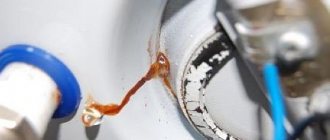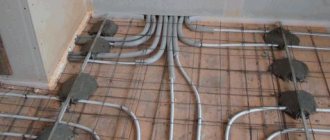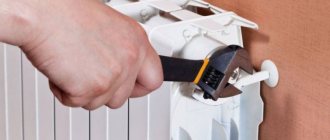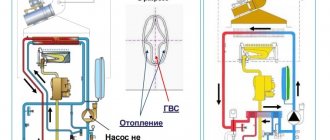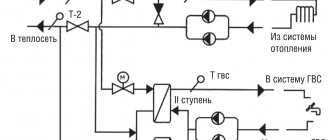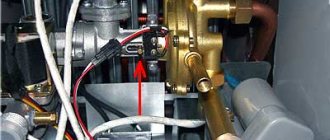Electric water heaters fail as often as other household appliances. This is due to poor water quality, damage to the electrical wiring, failure of the heating element, installation error or improper use of the equipment. Typical problems can be fixed on your own, without the involvement of specialists.
The lack of hot water negatively affects the usual way of life. If the water heater does not heat water and the light on it is on, you should worry about its speedy restoration.
If the listed elements do not work correctly (or fail), electric water heaters will not perform their main functions:
- Heating element - often fails due to prolonged use.
- The anode is a rod made of non-corrosive steel with a surface coating of magnesium. It attracts all the salts contained in the water. When actively using the water heater, it is recommended to replace the anode at least once a year .
- Thermostat is an internal element that controls water heating. In automatic mode, the element compares the current temperature with the user-set temperature and turns on/off the heating relay.
- Insulating gaskets are gaskets between the connecting elements of pipes and the water heater.
Determining the cause of the malfunction
Typical causes of malfunction of instantaneous water heaters and boilers include:
- poor water quality;
- error during installation of the device;
- damage to electrical wiring;
- improper operation.
Failure of the heating element is associated with the appearance of scale accumulating on the surface of the tank or due to a malfunction of the thermal protection button and safety valve.
Another common reason why a water heater does not heat water is a faulty electronic module of the device. It is strictly forbidden to replace it yourself , especially if the equipment is under warranty. Contact our specialist for qualified assistance.
To determine the cause of the malfunction, a careful visual inspection of the boiler is required. Be sure to pay attention to the light that lights up while the device is operating (when heating). If it doesn't light, try increasing the heating temperature. There may be 2 situations:
- The lamp (or indicator) lights up.
If the water heater does not heat water, but the indicator lights on the panel are on, this indicates a failure and the need to replace the heating element. You can verify this with a multimeter , which is connected to the device and adjusted to a certain resistance value. If you see zero on the indicator, the problem is a short circuit. You see the infinity symbol - there is an electrical break in the circuit.
It may also happen that when you turn on the device, the automation immediately turns it off. This is another indicator of failure of the tubular electric heater . Use a little trick to check! Fix the thermal protection button with your finger and turn on the water heater. If it starts to work, you can return it to its full state by removing the scale. At the same time, do not forget to check the condition of the anode.
- The lamp did not light up.
If there is no glow indicator on the display, you need to check with a tester whether voltage is supplied from the network to the thermostat . If voltage is passing to the thermostat, check the status of the input/output. If there is no data on the tester indicator, the heating element should be replaced.
Features of gas connections
When connecting gas stoves, water heaters and other types of equipment, flexible hoses are also used. Unlike water models, they are yellow and are not tested for environmental safety. For fixation, end steel or aluminum reinforcement is used. There are the following types of devices for connecting gas appliances:
- PVC hoses reinforced with polyester thread;
- made of synthetic rubber with stainless steel braid;
- bellows, made in the form of a corrugated stainless steel tube.
The Santekhkomplekt holding offers engineering equipment, fittings, plumbing fixtures and devices for connecting them to communications. The assortment is represented by products and materials from well-known foreign and domestic manufacturers. Discounts apply for bulk purchases, and product quality is confirmed by standard certificates. For information support and assistance, each client is assigned a personal manager. The ability to arrange delivery within Moscow and to other regions of the Russian Federation allows you to quickly receive the purchased goods without unnecessary hassle.
The boiler does not heat the water, the lamp is on
If the indicator light is on and the water is not heating, the problem can be solved in 2 ways:
- Perhaps the temperature control knob is set to the minimum value and the water in the tank simply cannot warm up to the desired temperature. In this case, simply increase the minimum heating level (turn the knob clockwise).
- The thermostat may have turned on. If this happens, simply turn on the thermal protection button. Please note that on water heaters Thermex, Baxi, Ariston and others, the button may be located in different places on the body .
DIY repair
If during the diagnostics it turns out that current is flowing to the boiler installation, it is necessary to disconnect the device from the network and find the thermal protection button on the thermostat, pressing it until it clicks. If after this, the boiler itself begins to work well, after a while it is necessary to remove the accumulated scale and see how the water heater works from the inside, it is possible to replace the magnesium anode.
As for the thermostat malfunction, it is easy to replace it yourself. As for repairs, it cannot be done in many water heaters, since electronic thermostats are used in domestic and foreign boilers. Repair is available for Ariston and Ti-Tech water heaters.
The water heater does not heat, the lamp does not light up
Another typical situation is that the boiler does not heat the water to the required temperature, and the indicator lamp does not light up. This indicates the following problems:
- presence of scale on the heating element;
- malfunction of the control board (electronic component);
- heating element malfunctions;
- failure of the safety valve.
To verify this, the water is completely drained from the tank and the device is disassembled. All internal electronic components should be checked using a multimeter, tester and voltage indicator. If you don’t have these devices at home or you don’t know how to use them, call a professional.
Briefly about the main thing
So, why doesn’t hot water flow from the water heater, and what are the main reasons for this:
- Broken or clogged back pressure valve: Often the valve becomes clogged with debris that makes its way through the pipeline to the water heater. In this case, you need to dismantle the device, check it for normal operation and the presence of contamination in it.
- The pressure reducer on the heater is incorrectly configured or broken: the equipment is designed in such a way that the same pressure at the supply is the same at the outlet. It is necessary to diagnose the device, and if this can be done optionally, then adjust the pressure.
- The tap on the water heater does not open completely: this is a kind of pressure limiter, in this case the breakdown is solved by replacing a new tap.
- The “mesh” filter on the mixer is clogged: this requires unscrewing the equipment and determining the presence of contaminants on the filter; this is probably the main problem.
The reasons why hot water does not flow from a water heater include both external factors that do not depend on its owner, as well as internal malfunctions of components. One way or another, the intervention of a specialist will be required, since it is not worth even cleaning the heating element yourself without experience - this often leads to fatal consequences. But if you carry out preventive maintenance in a timely manner, the equipment will work for a long time and without problems.
Boiler does not heat water well
Poor heating of water in a boiler in 90% of cases is caused by the condition of the heating element. The service life of this element is no more than 4 years. Over time, scale appears on its surface, reducing heat transfer. Sometimes an open circuit or short circuit occurs. This can only be determined with a multimeter. At the same time, be sure to pay attention to the condition of the thermostat !
The average boiler heating time is from 2 to 4 hours, depending on the volume of the tank. If it heats at half the set temperature, then there is a functional problem with the equipment.
Troubleshooting
Replacing the heating element
Replacing heating elements for water heaters Ariston, Electrolux, Termex and others is similar, despite the design differences and different appearance of the devices. For work you will need:
- wrenches (with socket heads);
- pliers;
- positive and negative screwdrivers;
- screwdriver with voltage indicator.
The sequence of actions is as follows:
- Close the water in the riser and drain the water inside the boiler.
- Disconnect the power supply to the electrical appliance.
- Remove the decorative cover that provides access to the electronic components and check that there is no voltage with an indicator screwdriver.
- Remove the terminals and disconnect the wires (be sure to remember the connection diagram). It would be a good idea to take a photo of the connection diagram.
Do not allow moisture to come into contact with the terminals, contacts and electronic board of the device to avoid short circuits and failure.
- After removing the cover and disconnecting the wires, remove the heating element.
- Check its condition, clean the anode from deposits.
Installing a new element is carried out in the reverse order, while remembering your own safety rules to avoid electric shock .
DIY repair
If during the diagnostics it turns out that current is flowing to the boiler installation, it is necessary to disconnect the device from the network and find the thermal protection button on the thermostat, pressing it until it clicks. If after this, the boiler itself begins to work well, after a while it is necessary to remove the accumulated scale and see how the water heater works from the inside, it is possible to replace the magnesium anode.
As for the thermostat malfunction, it is easy to replace it yourself. As for repairs, it cannot be done in many water heaters, since electronic thermostats are used in domestic and foreign boilers. Repair is available for Ariston and Ti-Tech water heaters.
Replacing the thermostat
To replace the thermostat, follow these steps:
- Remove the fixing ring (clamping) near the heating element.
- Remove the sensor adjustment unit and the thermostat itself.
- Install a new element.
- Secure it with a clamping ring.
- Check the condition (position) of the safety valve.
Please note that after replacing the thermostat, it is not recommended to immediately start operating the device! Check that cold water is flowing correctly inside, check that the connecting element does not hiss. The hot tap is then opened to release any air that has accumulated inside the boiler. Only after this can a test run be carried out .
The plug gets hot when the water heater is running
Heating of the fork (slight) is allowed during operation. But if it gets too hot, you need to:
- Visually check the condition of the tees and extension cords to which the device is connected. Try to choose an extension cord with a large cross-section of wire for fire safety purposes .
- Check the condition of the outlet to ensure that the water heater plug fits tightly into the sockets. In some cases, when a plug or socket is loose, the adjacent part of the wire may become hot.
An incorrectly selected extension cord can cause a fire in a house or apartment, since water heaters are powerful and energy-intensive devices (1.2-2.6 kW).
Instantaneous water heater does not heat water
In terms of quantity, suppliers sell instantaneous water heaters by an order of magnitude less than electric storage heaters. This is due to increased energy consumption. Typical reasons why instantaneous water heaters do not heat water:
- Faulty spiral . The best option is to replace the element. Winding nichrome thread will help solve the problem for just a few days. This increases the fire hazard.
Low water pressure . The water sensor does not send a heating signal to the coil through the electronic unit. A common problem with devices.
Radiator clogged . Disconnect the device from the electrical outlet and disassemble it. If the radiator is very clogged, you should place it in a lemon solution for several hours.
If you plan to not turn on the water heater for a long time (for example, while you are away from home for a long time), try to completely drain the water from the tank and hoses. This will eliminate the likelihood of scale and deposits appearing on the surface, and will also increase the service life of the device. When turned on, self-diagnostic devices will help check the condition and readiness for operation (error codes E2, E3 are shown or all indicators are flashing).
What are the consequences of excess moisture in the soil?
You can see the results of this phenomenon yourself - trees and shrubs die. Why is this happening?
- the oxygen content in the soil decreases and the carbon dioxide content increases, which leads to disruption of air exchange processes, water regime and nutritional regime in the soil;
- oxygen starvation of the root-forming layer occurs, which leads to the death of plant roots;
- the supply of macro and microelements by plants (nitrogen, phosphorus, potassium, etc.) is disrupted, because excess water washes out mobile forms of elements from the soil, and they become unavailable for absorption;
- intensive breakdown of proteins occurs and, accordingly, the processes of decay are activated.
Plants can tell you at what level groundwater lies
Take a close look at the flora of your area. The species inhabiting it will tell you at what depth the groundwater layers are located:
- perched water - it is best to dig a reservoir in this place;
- at a depth of up to 0.5 m - marigolds, horsetails, varieties of sedges grow - bladderwrack, holly, foxtail, Langsdorff's reed;
- at a depth of 0.5 m to 1 m - meadowsweet, canary grass, ;
- from 1 m to 1.5 m – favorable conditions for meadow fescue, bluegrass, mouse peas, rank;
- from 1.5 m - wheatgrass, clover, wormwood, plantain.
What is important to know when planning site drainage
Each group of plants has its own moisture needs:
- with a groundwater depth of 0.5 to 1 m, vegetables and annual flowers can grow in high beds;
- depth of water layer up to 1.5 m is well tolerated by vegetables, grains, annuals and perennials (flowers), ornamental and fruit shrubs, trees on a dwarf rootstock;
- if the groundwater is more than 2 m deep, fruit trees can be grown;
- The optimal depth of groundwater for agriculture is from 3.5 m.
Is site drainage necessary?
Record your observations for at least some time. You yourself can understand how much drainage is needed.
Maybe it makes sense to simply redirect melt and sediment water along the bypass channel, rather than allowing it to flow through your site?
Perhaps it is necessary to design and equip a storm drain and improve the composition of the soil and this will be enough?
Or is it worth making a drainage system only for fruit and ornamental trees?
A specialist will give you the exact answer, and we strongly recommend calling him. But after reading this article, you will gain some awareness on this issue.
Upon completion of the technological and production tasks associated with the arrangement of a sewer system in an apartment building, industrial building, as well as in a private household, it is necessary to test the involved system using the forced flow method. This task is used to identify possible defects or improper installation of the entire involved sewerage part, and the test report for internal sewerage and drainage systems will be material evidence of the work on acceptance of the facility.
A visual inspection should be accompanied by inclusion in the test report of internal sewerage and drainage systems according to SNIP, which is currently represented by the current regulations of the “D” series appendix, which corresponds to SP 73.13330.2012 “Internal sanitary systems of a building”, recently a new one has been applied updated working edition according to SNiP 3.05.01-85.

